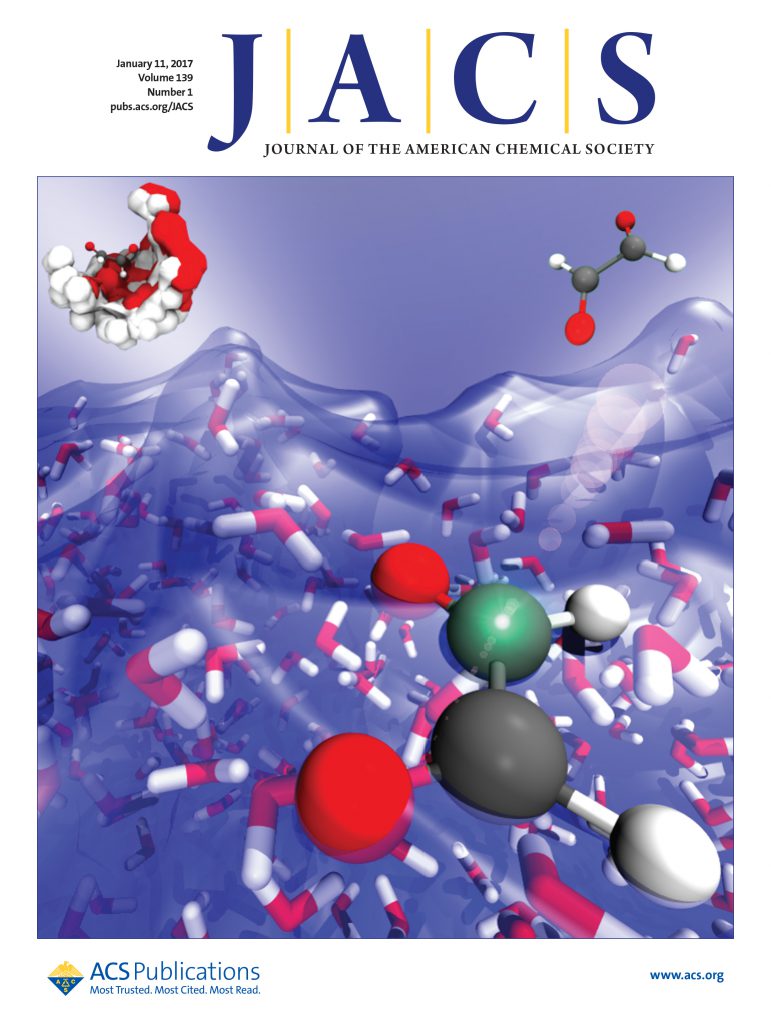可利用可见光获得最低能量电荷转移激发态的环金属化 Co(III)配合物
IF 15.6
1区 化学
Q1 CHEMISTRY, MULTIDISCIPLINARY
引用次数: 0
摘要
报告了 Co(III) 复合物顺式-[Co(PY)2(L)]PF6,其中 ppy = 2-苯基吡啶,L = bpy(2,2′-联吡啶;1)、phen(1,10-菲罗啉;2)和 DAP(1,12-二氮杂哌啶;3),并研究了它们的光物理特性,以评估它们作为敏化剂在太阳能转换方案和光氧化催化等应用中的潜力。计算表明,顺式-[Co(ppy)2(L)]PF6 系列中的环金属化作用产生了强烈的 Co(dπ)/ppy(π) 轨道相互作用,导致 Co/ppy(π*) 最高占有分子轨道 (HOMO) 和最低未占有分子轨道 (LUMO) 定位于二亚胺配体 L(π*)。配合物 1-3 显示出相对不变的氧化电位,而还原事件则取决于二亚胺配体 L 的特性,这与理论预测一致。对于 3,在 CH3CN 中观察到一条宽阔的 Co/ppy(π*) → L(π*) 金属/配体-配体电荷转移(ML-LCT)吸收带,最大波长为 507 纳米,延伸至 600 纳米以外。在激发 1ML-LCT 转变时,观察到与 3ML-LCT 激发态群一致的瞬态吸收特征,1、2 和 3 在 CH3CN 中的寿命τ 分别为 3.0 ps、4.6 和 42 ps。在 505 纳米波长的照射下,3 能够还原甲基紫精(MV2+),这是一种光催化方案中常见的电子受体。据我们所知,3 代表了第一个将环金属化与二亚胺配体相结合的异极分子 Co(III) 复合物,它具有最低的金属-配体电荷转移激发态,能够在低能量绿光下进行光诱导电荷转移。因此,3 的结构设计代表着向基于地球丰富金属的 d6 光敏剂迈出的重要一步。本文章由计算机程序翻译,如有差异,请以英文原文为准。

Cyclometallated Co(III) Complexes with Lowest-Energy Charge Transfer Excited States Accessible with Visible Light
The Co(III) complexes, cis-[Co(ppy)2(L)]PF6, where ppy = 2-phenylpyridine and L = bpy (2,2′-bipyridine; 1), phen (1,10-phenanthroline; 2), and DAP (1,12-diazaperylene; 3), are reported and their photophysical properties were investigated to evaluate their potential as sensitizers for applications that include solar energy conversion schemes and photoredox catalysis. Calculations show that cyclometallation in the cis-[Co(ppy)2(L)]PF6 series affords strong Co(dπ)/ppy(π) orbital interactions that result in a Co/ppy(π*) highest occupied molecular orbital (HOMO) and a lowest unoccupied molecular orbital (LUMO) localized on the diimine ligand, L(π*). Complexes 1–3 exhibit relatively invariant oxidation potentials, whereas the reduction event is dependent on the identity of the diimine ligand, L, consistent with the theoretical predictions. For 3 a broad Co/ppy(π*) → L(π*) metal/ligand-to-ligand charge transfer (ML-LCT) absorption band is observed in CH3CN with a maxima at 507 nm, extending beyond 600 nm. Upon excitation of the 1ML-LCT transition, transient absorption features consistent with the population of a 3ML-LCT excited state with lifetimes, τ, of 3.0 ps, 4.6 and 42 ps for 1, 2 and 3 in CH3CN respectively are observed. Upon irradiation with 505 nm, 3 is able to reduce methyl viologen (MV2+), an electron acceptor commonly in photocatalytic schemes. To our knowledge, 3 represents the first heteroleptic molecular Co(III) complex that combines cyclometallation with a diimine ligand with lowest-lying metal-to-ligand charge transfer excited states able to undergo photoinduced charge transfer with low-energy green light. As such, the structural design of 3 represents an important step toward d6 photosensitizers based on earth abundant metals.
求助全文
通过发布文献求助,成功后即可免费获取论文全文。
去求助
来源期刊
CiteScore
24.40
自引率
6.00%
发文量
2398
审稿时长
1.6 months
期刊介绍:
The flagship journal of the American Chemical Society, known as the Journal of the American Chemical Society (JACS), has been a prestigious publication since its establishment in 1879. It holds a preeminent position in the field of chemistry and related interdisciplinary sciences. JACS is committed to disseminating cutting-edge research papers, covering a wide range of topics, and encompasses approximately 19,000 pages of Articles, Communications, and Perspectives annually. With a weekly publication frequency, JACS plays a vital role in advancing the field of chemistry by providing essential research.

 求助内容:
求助内容: 应助结果提醒方式:
应助结果提醒方式:


